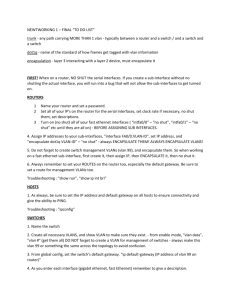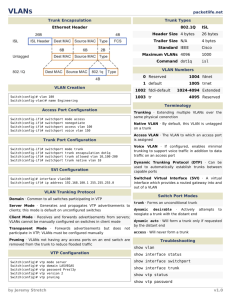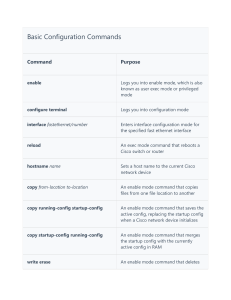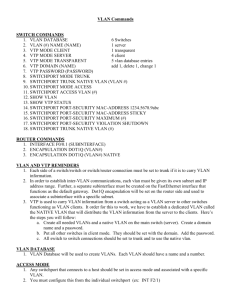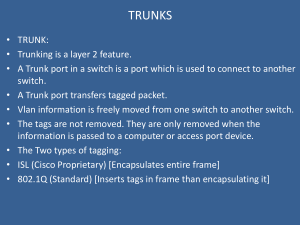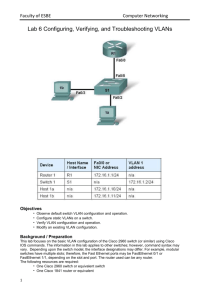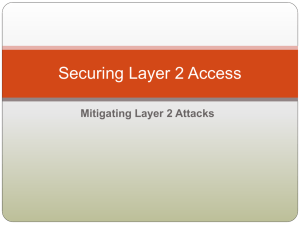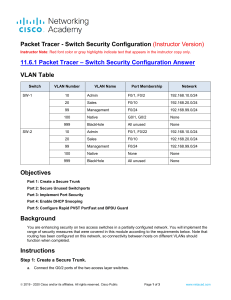Chapter 18
advertisement
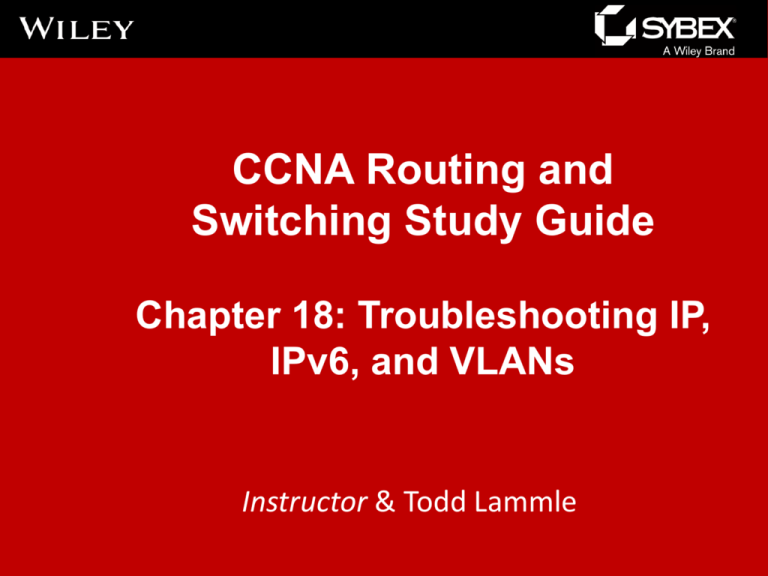
CCNA Routing and Switching Study Guide Chapter 18: Troubleshooting IP, IPv6, and VLANs Instructor & Todd Lammle Chapter 18 Objectives The ICND2 Topics Covered in this chapter include: • Troubleshooting – – – – – – – – – – – Identify and correct common network problems Troubleshoot and Resolve routing issues routing is enabled routing table is correct correct path selection Troubleshoot and Resolve interVLAN routing problems Connectivity Encapsulation Subnet Native VLAN Port mode trunk status 2 Troubleshooting scenario The Cisco objectives are clear on the troubleshooting steps you need to take when a problem has been reported, and here they are: 1. Check the cables to find out if there’s faulty cable or interface in the mix and verify the interface’s statistics. 2. Make sure that devices are determining the correct path from the source to the destination. Manipulate the routing information if needed. 3. Verify that the default gateway is correct. 4. Verify that name resolution settings are correct. 5. Verify that there are no access control lists (ACLs) blocking traffic. There are four steps for checking the PC1 configuration: 1. Test that the local IP stack is working by pinging the loopback address. 2. Test that the local IP stack is talking to the Data Link layer (LAN driver) by pinging the local IP address. 3. Test that the host is working on the LAN by pinging the default gateway. 4. Test that the host can get to remote networks by pinging remote Server1. IPv6 troubleshooting scenario Notice that I documented both the link-local and global addresses assigned to each router interface in the figure. Neighbor Discovery (NDP) Neighbor discovery enables these functions: Determining the MAC address of neighbors Router solicitation (RS) FF02::2 Router advertisements (RA) FF02::1 Neighbor solicitation (NS) Neighbor advertisement (NA) Duplicate address detection (DAD) Router solicitation (RS) and router advertisement (RA) IPv6 hosts send a router solicitation (RS) onto their data link asking for all routers to respond, and they use the multicast address FF02::2 to achieve this. Routers on the same link respond with a unicast to the requesting host, or with a router advertisement (RA) using FF02::1. Neighbor solicitation (NS) and neighbor advertisement (N) Hosts also can send solicitations and advertisements between themselves using a neighbor solicitation (NS) and neighbor advertisement (NA). VLAN connectivity A couple of key times to troubleshoot VLANs are when and if you lose connectivity between hosts and when you’re configuring new hosts into a VLAN but they’re not working. Here are the steps we’ll follow to troubleshoot VLANs: 1. Verify the VLAN database on all your switches. 2. Verify your content addressable memory (CAM) table. 3. Verify that your port VLAN assignments are configured correctly. And here’s a list of the commands we’ll be using in the following sections: Show vlan Show mac address-table Show interfaces interface switchport switchport access vlan vlan Trunk Troubleshooting And here are the commands we’ll use to perform trunk troubleshooting: Show interfaces trunk Show vlan Show interfaces interface trunk Show interfaces interface switchport Show dtp interface interface switchport mode switchport mode dynamic switchport trunk native vlan vlan Written Labs and Review Questions – Read through the Exam Essentials section together in class – Open your books and go through all the written labs and the review questions. – Review the answers in class. 11

